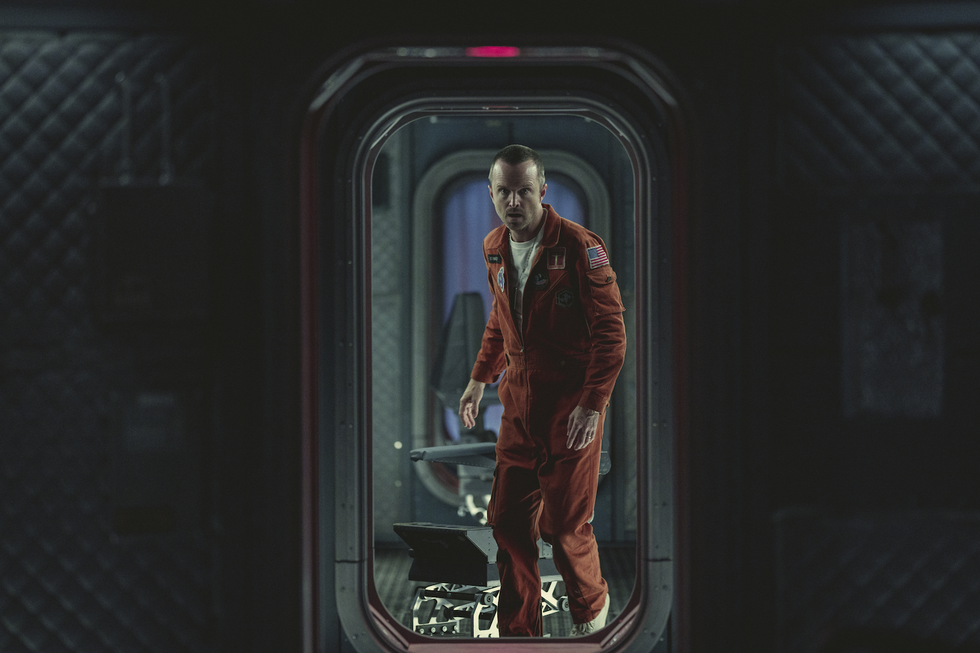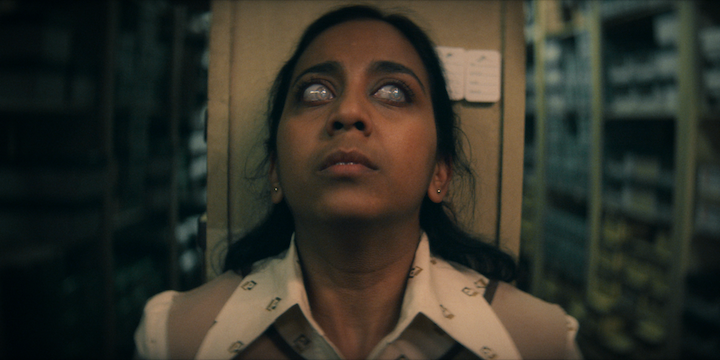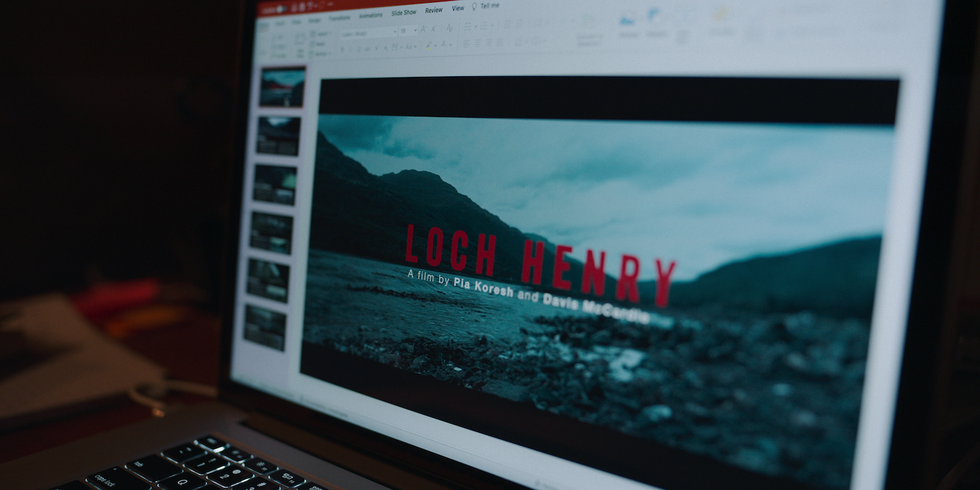Black Mirror Season 6 Episodes, Ranked: The Good, The Bad and The Existentially Harrowing
Spoilers below.
Black Mirror is back just when we need it most. The sixth season of Charlie Brooker’s anthology series has landed on Netflix as dystopia feels increasingly inevitable: war, wildfire, spiraling climate and financial crises, the rise of AI, and, oh yes, a once-in-a-century pandemic. Not since the series began has Brooker had such rich pickings to reinvent as a televisual nightmare. Considering all the showrunner has already pulled from his nightmare playbook, it was reasonable for fans to expect the latest season would skewer our tech-dependent culture in updated, yet recognizable ways.
How wrong we were. A week after all five episodes dropped, one thing is clear: This season of Black Mirror is not Black Mirror, or at least not as we once knew it. We can’t say Brooker didn’t warn us. In an interview with Tudum in June, he stressed that “Black Mirror should always be a show that can’t be easily defined, and can keep reinventing itself.” To that end, he admitted, “We’ve got a few new elements … to stretch the parameters of what a Black Mirror episode even is.”
More From ELLE

One element in particular threatens to stretch the show’s boundaries to a breaking point: In a fundamental shift for the sci-fi series, season 6 marks the first time that Black Mirror leans into the supernatural. Until now, the purpose of Black Mirror has been to cast a distorted reflection of our contemporary reality. Whether it’s the rating-obsessed sociopolitics of “Nosedive,” the accessible memory that haunts “The Entire History of You,” or the simulated reality at the heart of “San Junipero”: the show’s landmark episodes work by projecting our present into exhilarating, devastating futures. The series has always been an act of speculation, but each dreadful advance is only five years, months, or minutes away; the paradigm shift is disturbing because we can see it hurtling toward us. Consider that, six months ago, few among us knew anything about ChatGPT. Now we’re collectively fretting over how it could destroy our careers, our lives, and maybe the world—or, at least, reshape them in its image. Such accelerations seem like obvious grist for Brooker’s mill, but instead he’s opted for demons and werewolves. That changes everything.
That’s not to say the new iteration of Black Mirror isn’t fun. If you’ve grown tired of prior seasons’ high-tech terrors, a switch to the occult might be just the tonic. Season 5 was widely accepted as a low point, and with rival anthologies like the BBC’s Inside No.9 cranking out sharp half-hour episodes year over year, there was impetus for Black Mirror to do something dramatic to halt its own decline. (The addition of period settings and supernatural menace might shake up the game just enough to keep viewers tuned in.) Fans can point to the continued quality of the writing, which remains sharply trenchant about human nature, whether it’s under attack from monsters or malware. However, by relaxing the boundaries to accommodate the otherworldly, Brooker risks turning Black Mirror into a more generic show, with horrors that obey no rules and reflect nothing back at us but our most conventional fears.
No doubt Brooker will be delighted by the discourse he’s created regardless. After all, Black Mirror exists to invite opinion and confound consensus. Season 6 is no different. Variety and inconsistency are still baked into the structure. But in terms of which episodes represent Black Mirror at its best, here’s a thorough ranking of this season’s offerings, listed from least effective to most compelling.
5 | “Mazey Day”
Episode 4, “Mazey Day,” hits the bottom of this list largely thanks to its rushed pacing. Yes, the episode breaks the Black Mirror “rules” in several ways—period setting, a supernatural monster and an almost complete lack of tech—but none of those components are themselves to blame for how weakly “Mazey Day” lands its blows.
In the episode, we’re plunged into 2006: a distant past quickly established by a radio host announcing the birth of Siri Cruise. It’s an era of obsessive celebrity culture and upskirt tabloid snaps, in which we meet the titular starlet Mazey (Clara Rugaard) and reluctant paparazzo Bo (Zazie Beetz). Mazey has gone into hiding following a drunken hit and run, or so we’re led to believe. A morning-after conversation between Mazey and her Hollywood doctor mentions “getting you through tonight, and then tomorrow tonight,” and when Bo tracks Mazey down to a secluded facility the viewer is primed for a satire of celebrity rehab culture. Why has Mazey been riveted into her chamber? Why has she been chained? What horrors does this treatment entail?
It’s only when Bo and a gaggle of parasitical photographers break into Mazey’s room that we realize just how far off the rails this episode of Black Mirror is running. After a gurgled warning, Mazey transforms into a werewolf. The doctor’s “tonight and tomorrow night,” it turns out, is not some clichéd approach to sobriety, but a very real reference to the full moon. Cue slaughter—and some ridiculous scenes of paparazzi risking life and limb for “one more shot”—and the episode sprints to an anticlimactic end.
There is valuable subtext here. Mazey’s transformation is offered as an extreme example of the spectacle imposed upon and demanded of female bodies in the mid-noughties—but there’s not enough space or time in the episode to trace the point effectively. Instead, we’re given an underdeveloped rampage, straight from the recesses of Netflix’s horror catalog. A callous final shot undermines Bo’s entire character arc without offering anything we didn’t think about paparazzi already.
4 | “Beyond the Sea”
If “Mazey Day” feels too short to develop its ideas, episode 4, “Beyond the Sea,” has the opposite problem. With the freedom afforded by Netflix’s long-as-you-like structure, one has to question the pacing choices of devoting 80 minutes to two sad men sitting in static rooms.
Sure, fine, there’s a little more to it than that. “Beyond the Sea” transports us to an alternative 1969 when, rather than making virgin landings on the moon, the U.S. space program is conducting a 6-year mission. The men enduring this journey are David (Josh Hartnett) and Cliff (Aaron Paul), a pair of astronauts who seem to barely know each other. This may be partly because, though their bodies are aboard a distant spaceship, they spend the majority of their time with their consciousness beamed down to avatars on Earth. They only seem to be needed in space when their watches ring an alarm, or for their mandated weekly fitness test. When something goes truly, disastrously awry in David’s domestic life—courtesy of a Manson-esque cult—he’s left trapped in space, alone with his grief.
When Cliff and his wife Lana (Kate Mara) offer David the chance to use Cliff’s replica for a vacation of sorts, anyone who’s seen an episode of Black Mirror—or indeed read any science fiction—will mutter, “That’s not a good idea.” Weirdly, it’s also at this point that “Beyond the Sea” loses its urgency. For much of the remainder of the episode, the three characters fall into a holding pattern. A predictable frisson grows between Lana and David, the man who is able to look like her husband but who is a) artistic and b) grieving, so therefore c) more soulful.
Paul does put in a fantastic performance as two very different men. One scene in which he lets the full wave of David’s grief wash across his face is the single best moment in the entire season. Equally, he does a good job evoking Cliff’s slow-burning jealousy, but here the writing lets him down. Cliff is aware that David is growing obsessed with Lana but still makes the bewildering decision to allow him to use his replica “one last time.” It does not go well.
True, the final twist is a shocker: an act of petty malice that’s supposed to lock Cliff and David into a hellish equilibrium. It’s made clear early on that both men are required to safely complete the mission; if they can’t work together, they will both die in space. It could be seen as a classic example of the existential prisons that Black Mirror sets up so well. But, in truth, the episode’s climax rings a clanging note: It turns the only female character in the piece into a toy to be coveted and stolen. In the end, “Beyond the Sea” is a story not about technology, but about male ego and spite. Whether Brooker meant it that way or not is hard to say, but does it have to take up so much time…?
3 | “Joan is Awful”
The only episode of the season to feel like it’s navigating familiar territory, episode 1, “Joan is Awful” is one of two season 6 installments that turns Brooker’s bite toward the hand that feeds him. The episode centers around Streamberry, an online streaming service that’s Netflix in all but name. When Joan (Schitt’s Creek’s Annie Murphy) finds that her life is being dramatized on the platform in next-to-real-time, she loses her job, her boyfriend and any public goodwill. In some ways, it can be seen as a comedic riposte to season 2’s classic “White Bear”—complete with intrusive media and individual torment recast as spectacle.
For a good portion of the episode, it seems unclear whether “Joan is Awful” is aiming for Truman Show-style comedy or existential dread. Part of the nightmare of it all is that Joan’s real-world behavior is subtly rewritten to cast her in the worst possible light. It’s a terrifying extension of what the endless digital filters of modern life can do to a person. However, cue a wonderfully scatological scene in a church and the entrance of Salma Hayek, and suddenly the balance tips back toward the whimsical.
If anything holds “Joan is Awful” back, it’s the range of its targets. Brooker goes after streaming culture, AI, algorithmic manipulation, deepfakes, and more. It’s enough for a whole season in itself, but when boiled down to one episode “Joan is Awful” struggles to make a precise point. A tagged on “happy” ending leaves us unsure as to what we should take from the drama. Is Brooker suggesting that Netflix is a curse to be purged? Should we all cancel our streaming services? Is he, in fact, writing the whole thing in solidarity with the WGA picketers? I’d like to think so, because “Joan is Awful” is a flawed, fun hour of TV, but I imagine it was only half as entertaining as the meeting in which Brooker pitched it to his producers.
2 | “Demon 79”
Episode 5, “Demon 79,” is the least “Black Mirror” Black Mirror episode of this or any season. An apocalyptic-Faustian bargain-cum-weird-rom-com, it has no technological component of note and even begins with the title card “Red Mirror,” as if to differentiate it from its own franchise.
It is, however, very funny. Nida (Anjana Vasan) is a shopworker in late ’70s Britain. Her day is a mire of microaggressions, from the racial slurs of her co-worker Vicky, to her manager’s entreaties that she eat her pungent biryani in the basement. It’s whilst she’s down there that she finds the talisman that summons the demon Gaap (Paapa Essiedu), who arrives with a friendly ultimatum: sacrifice three human lives in three days, or the world will end. What ensues is an oh-so-British farce of violent proportions as Nida overcomes her reservations—or perhaps gives vent to her urges—to stave off nuclear Armageddon.
The plot itself is fairly thin for an hour-plus run-time; though unlike “Beyond the Sea,” “Demon 79” is much more enjoyable because it takes itself so much less seriously. Most of the delight is found in the banter between Niga and Gaap, who, in Nida’s eyes, “looked like a monster at first, then he turned into the man from Boney M.” The writing is unambiguously comic, and Essiedu delivers each line with manic, cockney relish. At one point, he casts his eyes over a victim’s living room and remarks, “It looks like he wipes his arse with his house.”
At the same time, racial and political tensions run like humming electrical cables beneath the pantomime. A subplot about a Tory politician reads like a reference to Stephen King’s The Dead Zone. Just like the lowly hero of King’s novel, Nida is given supernatural insight into the politician’s future: a rising tide of fascism, complete with numerous visual references to past Black Mirror episodes. If, as fan theories and Easter eggs suggest, the majority of Black Mirror stories occur in the same universe, then it’s possible to interpret “Demon 79” as an origin story of all we’ve seen play out in previous seasons.
The episode ends on the greatest downer of all, as bombs fall and the world burns, but Brooker finds solace in personal choice. Faced with death on earth, or eternal oblivion in Gaap’s outer dark, Nida chooses to accompany her friend. It’s a weirdly touching finale to a season that offers plenty of ideas but few transcendent moments. “Demon 79” might be the furthest thing from what we consider a typical Black Mirror episode, but it’s such charming good fun that it’s hard to hold that against it.
1 | “Loch Henry”
Episode 2, “Loch Henry” is easily the best of this season’s inconsistent crop. It might not have contemporary technology at its thematic core, but it’s the episode that comes closest to the unsettling vibe that’s made Black Mirror so memorable in the past. Free of the trappings of either science fiction or the supernatural, it’s a bleak examination of true crime and the commercialization of trauma.
Davis (Samuel Blenkin) and Pia (Myha’la Herrold) are a pair of young documentarians on their way to the north of Scotland to make a film about egg collecting. Along the way they stop at Davis’ family home, where they become (re)acquainted with the hideous crimes of local boogeyman Iain Adair. Pia is keen to plumb the story for a more salacious documentary that they can sell to Streamberry. (This is the second time the streamer pops up this season and, in a nice connective flourish, the documentary that Davis ends up making appears as a piece of content on the platform in “Joan is Awful.”) At one point, Davis’ friend, Stuart, is discussing how an attractively packaged documentary could resurrect the local tourist scene. It’s a crass way to frame the torture and murder of tourists, but it’s understandable. Horror sells, as Brooker knows all too well. The more biting insight comes when Stuart casually asks Pia, “What was that thing, about the man who killed women?”
“Perhaps narrow it down,” she replies.
For all its digital references, it’s “Loch Henry”’s use of analogue technology that most disquiets. As Davis and Pia look deeper into the case, the existence of a stack of VHS tapes looms ever larger. The twist is satisfying enough that I’ll shy away from discussing it here, mostly because the actual reveal is both horrifying and grimly hilarious. Horror fans will probably guess it anyway, but this isn’t an episode that revolves around surprise. Instead, “Loch Henry” harkens back to a time when technology was raw and inalienable and seemed weighted with truth rather than burdened with deceit—and to a time when Black Mirror knew what it wanted to be.
Neil McRobert is a UK-based writer, researcher and podcaster, with a specialism in horror and other darkly speculative fascinations. He is the host and producer of Talking Scared podcast.






